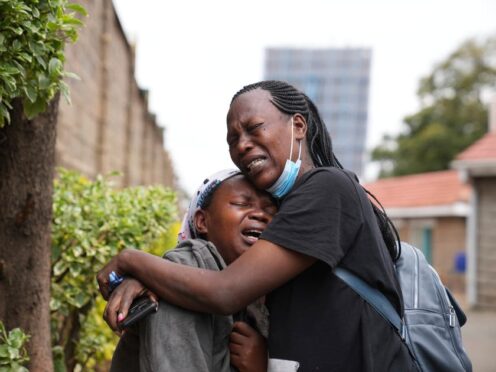
The Kenyan military remains in the streets of the capital Nairobi a day after protesters stormed parliament over a tax plan that would increase the cost of living – an act of defiance that President William Ruto called an “existential” threat.
At least 22 people were killed during the unrest, a human rights group said.
Nairobi has seen protests in the past, but activists and others warned the stakes are high after the biggest assault on Kenya’s government in decades.

Mr Ruto called the events “treasonous” and vowed to quash unrest “at whatever cost”.
Soldiers patrolled alongside police, who have been accused of shooting several people dead on Tuesday.
More protests are expected as Kenyans unite beyond tribal and other divisions in a youth-led effort to keep the finance bill from becoming law.
The legislation would raise taxes and fees on a range of daily items and services, from egg imports to bank transfers, increasing the pain of a majority of the country’s people who struggle to get by.
The government is intent on raising revenue to pay off debt in East Africa’s economic hub.
There were no reports of violence on Wednesday, but there was fear as the smell of tear gas lingered in the air of the capital. Civil society groups have reported abductions of people involved in recent protests and expect more to come.
Herman Manyora, an analyst and professor at the University of Nairobi, said: “We are dealing with a new phenomenon and a group of people that is not predictable. If it would have been the normal demonstrations, I’d say it will fizzle out with time, but we don’t know whether these people will fear the army.”

He said Kenya’s president missed an opportunity in his national address on Tuesday night speech to calm tensions and adopt a more conciliatory approach.
“We expected him to appreciate the gravity of the issue and empathize with the young people,” Mr Manyora said.
“Instead, people saw an angry president who is reading a riot act to the nation.”
Many young people who helped vote Ruto into power on the strength of his promises of economic relief now object to his proposed reforms.
Thousands stormed parliament on Tuesday, and part of the building burned. Clashes occurred in several communities beyond the capital.
At least 22 people were killed, the Kenya National Human Rights Commission said. Commission chairperson Roseline Odede told journalists that 300 others were injured and 50 people were arrested.
The mother of a teenager who was killed, Edith Wanjiku, told journalists at a mortuary that the police who shot her son should be arrested and charged with murder because her 19-year-old son had been unarmed.
“He had just completed school and was peacefully protesting,” she said.
Parliament, city hall and the supreme court were cordoned off Wednesday with tape reading: “Crime Scene Do Not Enter”.

Authorities said police fired over 700 blanks to disperse protesters in the Nairobi suburb of Githurai overnight. Videos of the gunfire were shared online.
Opposition leader Raila Odinga condemned the killing of protesters and “brute force” of authorities and called for dialogue, asserting that Kenya’s constitution had been suspended.
“Kenya cannot afford to kill its children just because the children are asking for food, jobs and a listening ear,” Mr Odinga said in a statement.
In Nairobi, a regional hub for expatriates and home to a United Nations complex, inequality among Kenyans has sharpened along with long-held frustrations over state corruption. A booming young population is also frustrated by the lavish lifestyles of politicians including the President.
Some who had passionately supported Mr Ruto, who won the presidency by portraying himself as a “hustler” of humble background, feel betrayed.
I am deeply saddened by the reports of deaths and injuries – including of journalists and medical personnel – connected to protests and street demonstrations in Kenya.
I urge the Kenyan authorities to exercise restraint, and call for all demonstrations to take place peacefully.
— António Guterres (@antonioguterres) June 26, 2024
The events mark a sharp turn in fortunes for Mr Ruto, who has been embraced by the United States as a welcome partner in Africa while frustration grows elsewhere on the continent with the US and some other Western powers.
In May, Mr Ruto went to Washington in the first state visit by an African leader in 16 years. On Tuesday, as the protests exploded, the USdesignated Kenya as its first major non-Nato ally in sub-Saharan Africa, a largely symbolic act but one highlighting their strong security partnership.
Also on Tuesday, hundreds of Kenyan police deployed to lead a multinational force against gangs in Haiti, an initiative that brought thanks from US President Joe Biden.
Now Kenya’s president and his government – along with protesters – face pleas for calm and pressure from partners including the US, which joined a dozen other nations in a statement Tuesday expressing “deep concern” over the violence and abductions.

Enjoy the convenience of having The Sunday Post delivered as a digital ePaper straight to your smartphone, tablet or computer.
Subscribe for only £5.49 a month and enjoy all the benefits of the printed paper as a digital replica.
Subscribe